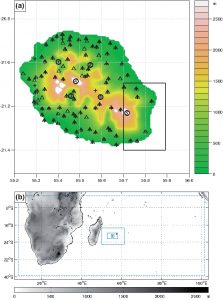l’article du mois – septembre 2014
 Regionalizing rainfall at very high resolution over La Réunion island using a regional Climate Model
Regionalizing rainfall at very high resolution over La Réunion island using a regional Climate Model
par Béatrice Morel, Yves Richard, Benjamin Pohl, Benjamin Bois et Miloud Bessafi
Monthly Weather Review, DOI: 10.1175/MWR-D-14-00009.1
Regional climate models (RCMs) should be evaluated with respect to their ability to downscale large-scale climate information to the local scales, which are sometimes strongly modulated by surface conditions. This is the case for La Reunion (southwest Indian Ocean) because of its island context and its complex topography. Large-scale atmospheric configurations such as tropical cyclones (TCs) may have an amplifying effect on local rainfall patterns that only a very high-resolution RCM, forced by the large scales and resolving finescale processes, may simulate properly.
This paper documents the capability of the Weather Research and Forecasting Model (WRF) RCM to regionalize rainfall variability at very high resolution (680m) over La Reunion island for daily to seasonal time scales and year-to-year differences. Two contrasted wet seasons (November–April) are selected: 2000–01 (abnormally dry) and 2004–05 (abnormally wet). WRF rainfall is compared to a dense network of rain gauge records interpolated onto the WRF grid through the regression-kriging (RK) technique. RK avoids the point-to-grid comparison issue, but produces imperfect estimates due to sampling, so its quality also needs to be tested.
Seasonal rainfall amounts and contrasts produced by WRF are fairly realistic. At intraseasonal and daily time scales, differences to RK are more sizable. These differences are not easy to interpret in sectors where the rain gauge network is less dense and the quality of RK more uncertain, as over the eastern slopes of Piton de la Fournaise volcano where WRF seems to simulate more realistic rainfall than RK. Finally, the heavy rainfall associated with TC Ando on 6 January 2001, is documented. WRF shows weak disagreements with RK, indicating its capability to regionalize rainfall during extreme events.
- extrait:
- lien_externe:
- kc_data:
- a:8:{i:0;s:0:"";s:4:"mode";s:0:"";s:3:"css";s:0:"";s:9:"max_width";s:0:"";s:7:"classes";s:0:"";s:9:"thumbnail";s:0:"";s:9:"collapsed";s:0:"";s:9:"optimized";s:0:"";}
- kc_raw_content:
 Regionalizing rainfall at very high resolution over La Réunion island using a regional Climate Model
Regionalizing rainfall at very high resolution over La Réunion island using a regional Climate Model
par Béatrice Morel, Yves Richard, Benjamin Pohl, Benjamin Bois et Miloud Bessafi
Monthly Weather Review, DOI: 10.1175/MWR-D-14-00009.1
Regional climate models (RCMs) should be evaluated with respect to their ability to downscale large-scale climate information to the local scales, which are sometimes strongly modulated by surface conditions. This is the case for La Reunion (southwest Indian Ocean) because of its island context and its complex topography. Large-scale atmospheric configurations such as tropical cyclones (TCs) may have an amplifying effect on local rainfall patterns that only a very high-resolution RCM, forced by the large scales and resolving finescale processes, may simulate properly.
This paper documents the capability of the Weather Research and Forecasting Model (WRF) RCM to regionalize rainfall variability at very high resolution (680m) over La Reunion island for daily to seasonal time scales and year-to-year differences. Two contrasted wet seasons (November–April) are selected: 2000–01 (abnormally dry) and 2004–05 (abnormally wet). WRF rainfall is compared to a dense network of rain gauge records interpolated onto the WRF grid through the regression-kriging (RK) technique. RK avoids the point-to-grid comparison issue, but produces imperfect estimates due to sampling, so its quality also needs to be tested.
Seasonal rainfall amounts and contrasts produced by WRF are fairly realistic. At intraseasonal and daily time scales, differences to RK are more sizable. These differences are not easy to interpret in sectors where the rain gauge network is less dense and the quality of RK more uncertain, as over the eastern slopes of Piton de la Fournaise volcano where WRF seems to simulate more realistic rainfall than RK. Finally, the heavy rainfall associated with TC Ando on 6 January 2001, is documented. WRF shows weak disagreements with RK, indicating its capability to regionalize rainfall during extreme events.
